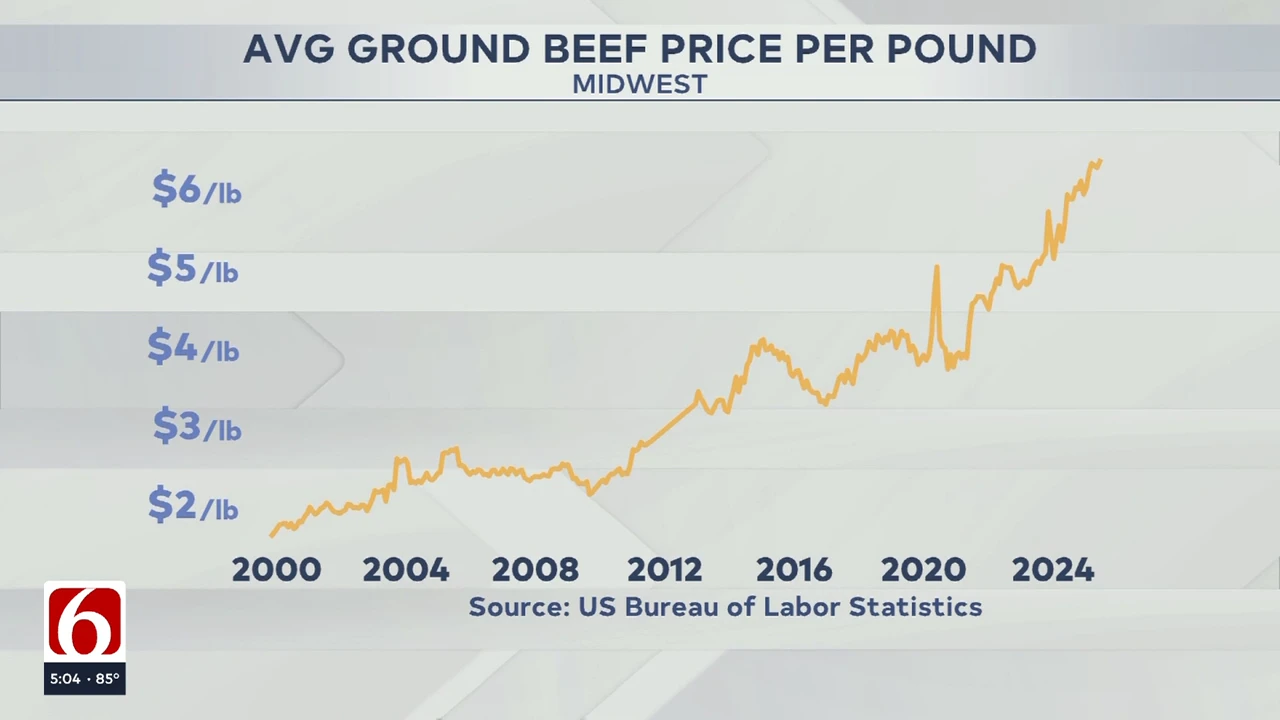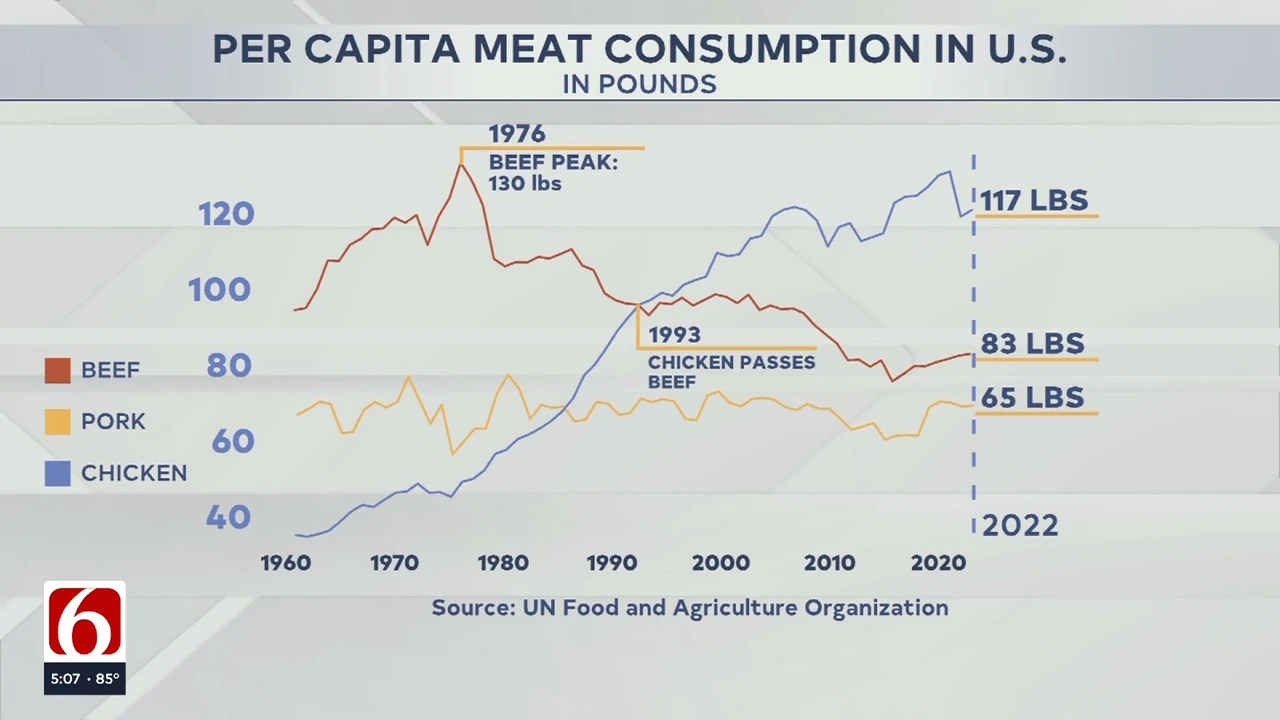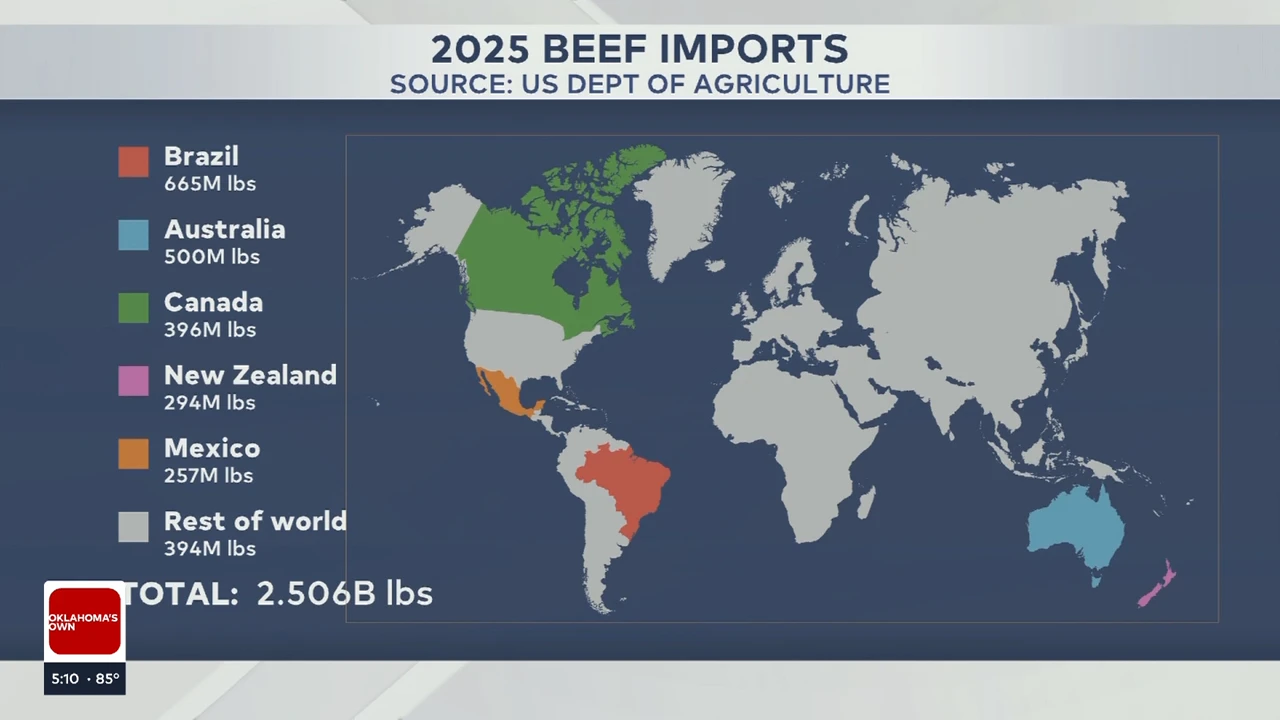Oklahoma’s Own In Focus: Higher beef prices benefit agriculture, but shoppers feel the pinch
Beef prices have risen 12% from last year, impacting Oklahoma consumers but aiding agriculture. Understand the reasons, including supply, demand, and higher ranching costs.Tuesday, August 12th 2025, 10:31 am
TULSA, Okla. -
Beef prices are up, including ground beef, which is 12% higher than this time last year. Experts don’t think the prices will drop anytime soon. While it’s not good news for shoppers, it is beneficial for the agriculture industry, one of the top industries in Oklahoma.
A lot goes into the cost of beef, including supply and demand, imports and tariffs, higher costs for ranchers on things like feed, and much more.
State of Cattle
Part of the reason for the higher cost of beef is the lower supply. Due to smaller herds, the Tulsa Stockyards says 10 million fewer head of cattle are moving through their auction compared to five years ago. Right now, the price of cattle at auction is more than $4 per pound.
Historical Beef Prices
Mostly because of drought, the inventory of cattle is at its lowest point since 1951.
The low supply is one big reason people are paying more for beef.
The U.S. Bureau of Labor Statistics says the average price of a pound of ground beef in the Midwest is more than $6 right now, up from $1.33 25 years ago. The consumer price index calculation shows that $1.33 in 2000 should be equal to $2.54 today. Beef prices have jumped 468% since 2000, or an average of 18% a year.

Beef is the most expensive meat on the market right now. Chicken is $2.23 per pound, and pork just passed the $5 mark. The cut of meat you buy always affects the price, so steak is higher than ground beef.
Related Story: How Much Higher Is The Cost of Beef: A By-The-Numbers Breakdown
Tulsa Stockyards Battle Low Cattle Numbers
Q: Why is the cattle inventory low?
A: About four years of drought forced many ranchers to sell their herds. Blaine Lotz, auctioneer at the Tulsa Stockyards, says that without enough water, feed, or hay, many had no choice but to downsize or get rid of their herds altogether.
“They were basically forced to sell their cattle, and with that, these prices have started to just rise and rise and rise,” Lotz said. “In my opinion, it’s virtually the sole aspect of why this market is the way it is today. Five years ago, we had millions more cattle.”
Lotz says the industry has still not recovered.
Q: Are higher prices helping ranchers?
A: Not entirely. Joe Don Eaves, owner of the Tulsa Stockyards, says that while cattle prices are high, so are the costs of raising them.
“When the numbers are low and the demand is high, it makes the market better and the prices are better,” Eaves said. “But you know, cattle is high and we are thankful for that, but everything else is high too. Our input costs are really expensive; it costs a lot more to raise cattle than it used to, and these prices are going to have to stay this good to keep people in the business.”
Expenses like land, fuel, fertilizer, equipment, and insurance have all increased. Many ranchers are using the extra money just to cover these rising costs. Eaves also says high land prices are having an effect.
“Land values are so expensive, it’s hard for people to get into the cattle business, even with the prices we are getting today. It’s hard for people to get into the business,” Eaves said.
Q: What role do land prices play in the industry’s struggles?
A: Eaves says land prices have skyrocketed, making it difficult for younger ranchers to get started.
“The land values are so expensive, it’s hard for a young person to get into the business,” Eaves said.
In many cases, Eaves says land is being sold for developments or industrial use instead of cattle production.
“Years ago, there were many ranchers wanting to buy land; now there are people who want it for developments, industrial-type stuff,” Eaves said. “It’s eliminated a lot of the land that is used for cattle production, which has made the numbers really low.”
Q: What’s next?
A: Due to the high amount of rainfall in Oklahoma, ranchers are baling more hay.
“It’s been a great year,” Eaves said. “People have been able to make a lot of hay; it’s been an awesome year. We have had a lot of rainfall. This year has been a great year for cattle production.”
Eaves hopes it will lead to a higher supply of cattle, but it could take two to three years for cattle numbers to rebound.
Changes in Consumer Trends
Americans still eat the most red meat of any country. Americans ate nearly 265 pounds of meat in 2022, with nearly half of that coming from chicken. Pork has been steady through the years, but chicken outpaced beef in the 90s, and demand has only grown.
First, chicken production has grown rapidly.
Second, poultry production is cheaper, faster, and takes less space, which means more supply and lower costs.
And third, many people are eating less red meat for health reasons.
How Beef Prices Are Affecting Consumers
Inflation is another reason for the higher cost, which is affecting both bigger and smaller businesses. Summer is the season of grilling, and things like burgers and steaks are popular proteins to put on the menu. However, with the cost of beef nearly 50 cents to a dollar higher per pound at the grocery store compared to last year, some shoppers say they are cutting back.
 Image Provided By: UN Food and Ag. Org.
Image Provided By: UN Food and Ag. Org.
“At $10 for ground beef a pound, yeah, it’s expensive,” said Pamela Flowers from Mannford.
“I make it stretch as far as I can,” shopper Tammy McCoy said. “We do like chicken sometimes. Pork, mainly chicken.”
Chris Gabriel owns Wild Country Meats in Cleveland. He buys cattle ready for slaughter and processes the meat. He says the cost of doing business is driving up prices for everyone.
“You’ve got labor expenses up and then packaging material is up,” he said. “Transportation, fuel expense, that kind of stuff. All of that has gone up. But just the supply chain, the meat itself, like the supply of cattle, that price has gone up so high. It’s just caused meat prices to go up.”
“In 2020, two fattened cattle, which are cattle that are ready to be delivered to the butcher, were trading at $1.37 a pound. Then in 2023, that went up to $1.78 a pound. And these are live weight costs, right? Then in 2024, it jumped to $1.93. And today, they’re trading for $2.34 a pound. So that’s $1 more per pound for a 1,200- to 1,400-pound animal. That’s $1,200 to $1,400 more per beef.”
Gabriel sells more than just beef products and says business hasn’t taken a big hit. Customers like Tammy say they’ll just suck it up until things get better.
“That’s what it’s going to be until we get things straightened out,” she said. “So keep going higher and higher.”
Global Impact
The U.S. does plan to import more beef from other countries to help boost supply and hopefully lower the cost. America has imported more than 2.5 billion pounds of beef so far this year, mostly coming from Brazil, Australia, Canada, New Zealand, and Mexico. That’s 600 million more pounds than all of last year, and it’s only August.
But a lot of the imports from Mexico have been stopped right now because of fears of the spread of the screwworm, which can kill cattle.
New tariffs could raise prices on imports, so it’s not clear if more supply will lead to lower prices. President Trump has announced new trade deals to export American beef to the U.K. and Australia, which helps ranchers but will impact supply here.
 Image Provided By: US Dept. Of Ag.
Image Provided By: US Dept. Of Ag.
How to Save Money
Some folks are turning to less expensive meats to save money. Many families are buying chicken and pork instead or buying lesser-quality cuts.
You can also save some money by buying in larger quantities from wholesale stores or buying whole cuts of cattle and getting them processed, but that takes freezer space.
Home economists also say you can get more mileage out of your meat dishes by adding vegetables.
Erin Conrad
Erin Conrad joined the News On 6 team in 2014 as a general assignment reporter and quickly fell in love with Tulsa. After leaving in 2018 Erin happily rejoined the team in April of 2024. Erin has contributed to the reporting of two major stories that earned KOTV two Murrow Awards. You can now find her anchoring on weekends and reporting during the week.
More Like This
August 12th, 2025
September 4th, 2025
September 4th, 2025
September 4th, 2025
Top Headlines
September 4th, 2025
September 4th, 2025
September 4th, 2025
September 4th, 2025








